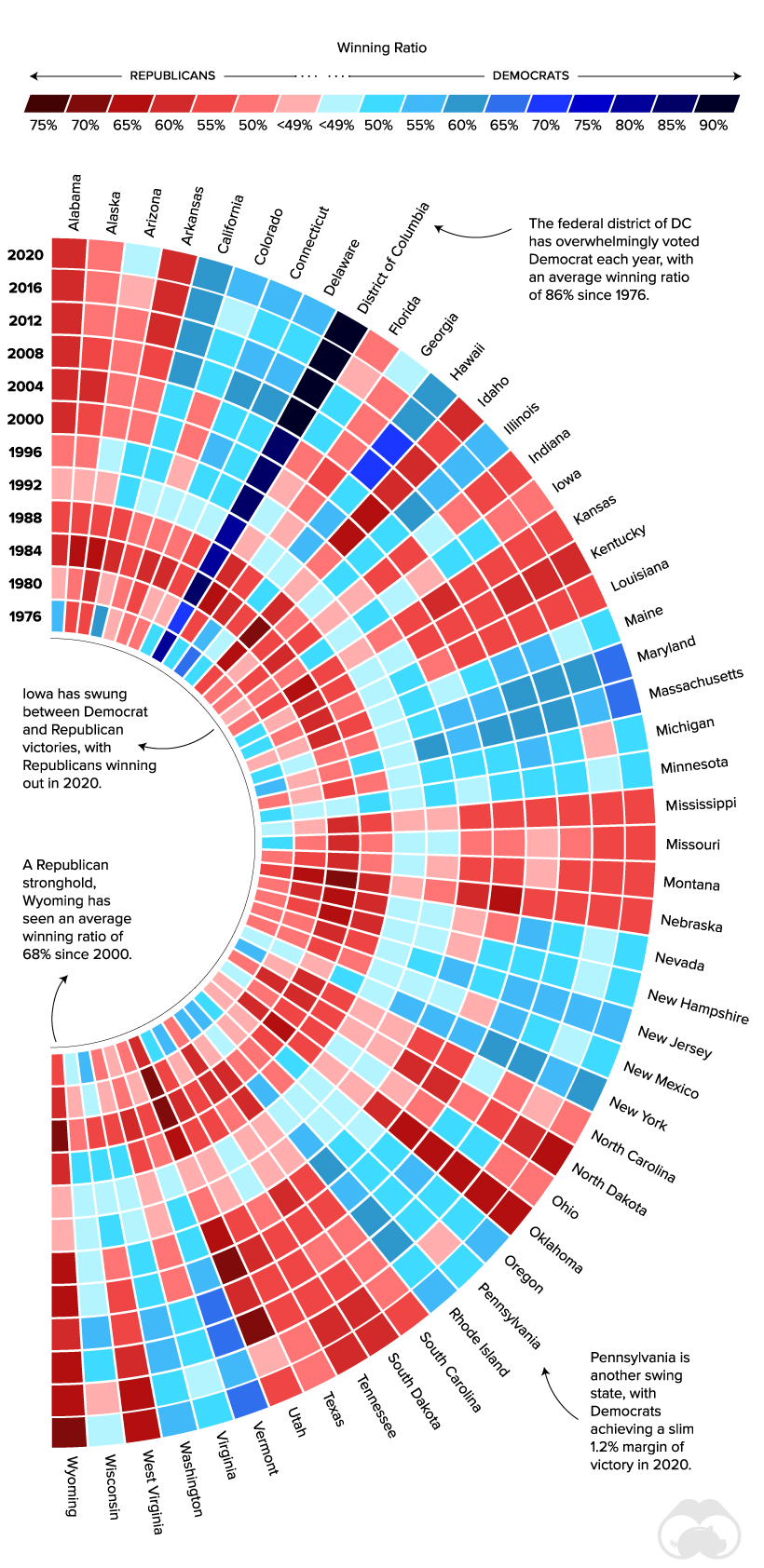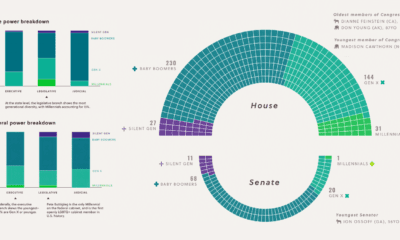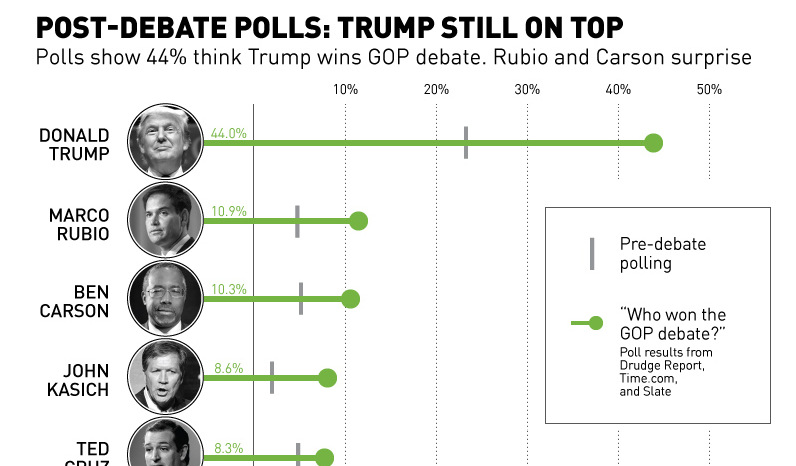In this graphic, we use data from the U.S. National Archives and the MIT Election Data and Science Lab to show U.S. presidential voting history by state since 1976. Note: this post has been updated on January 19, 2021 to reflect the latest data.
Each State’s Winning Party
To calculate the winning ratio, we divided the votes for the state’s winning party by the total number of state votes. Here’s another look at the same data, visualized in a different way.
This graphic was inspired by this Reddit post. As the voting history shows, some states—such as Alaska, Oklahoma, and Wyoming—have consistently supported the Republican Party. On the other hand, Hawaii, Minnesota, and the District of Columbia have been Democrat strongholds for many decades. The District of Columbia (D.C.) is a federal district, and is not part of any U.S. State. Its population is urban and has a large percentage of Black and college-educated citizens, all of which are groups that tend to identify as Democrat. Swing states typically see a close contest between Democrats and Republicans. For example, Florida’s average margin of victory for presidential candidates has been just 2.7% since 1996. It’s often seen as a key battleground, and for good reason: the state has 29 electoral college votes, meaning it has a high weighting in the final outcome.
Memorable Election Years
Within U.S. presidential voting history, some election results stand out more than others. In 1984, President Reagan was re-elected in a landslide victory, winning 49 out of 50 states. The remarkable win has been credited to the economic recovery during Reagan’s first term, Reagan’s charisma, and voters’ opposition to the Democrat’s planned tax increases. In 1992, self-made Texas billionaire Ross Perot ran as a third-party candidate. He captured almost 19% of the popular vote, the highest percentage of any third-party presidential candidate in over 80 years. While he gained support from those looking for a change from traditional party politics, Bill Clinton ultimately went on to win the election. Most recently, the 2020 election had a record voter turnout, with 66.3% of the eligible population casting a ballot. There was also a record number of mail-in ballots due to the COVID-19 pandemic. This led to widespread allegations of voter fraud, with President Trump and his allies filing 62 lawsuits seeking to overturn election results. In the end, 61 of the lawsuits were defeated and congress confirmed Joe Biden’s victory.
Voting History of Swing States
Both Trump and Biden focused on battleground states in 2020, but where were they successful? Here are nine of the swing states, and their voting history over the last two elections. The Republican party won four of the swing states in 2020, including Florida. However, 2020 was the first year since 1964 that the candidate who won Florida did not go on to win the election. Five of the states—Arizona, Georgia, Michigan, Pennsylvania, and Wisconsin—flipped allegiance to the Democrats. In Georgia, the margin of victory was as small as 0.24% or about 12,000 votes. Ultimately, winning over these states helped lead to a Biden victory. on Even while political regimes across these countries have changed over time, they’ve largely followed a few different types of governance. Today, every country can ultimately be classified into just nine broad forms of government systems. This map by Truman Du uses information from Wikipedia to map the government systems that rule the world today.
Countries By Type of Government
It’s important to note that this map charts government systems according to each country’s legal framework. Many countries have constitutions stating their de jure or legally recognized system of government, but their de facto or realized form of governance may be quite different. Here is a list of the stated government system of UN member states and observers as of January 2023: Let’s take a closer look at some of these systems.
Monarchies
Brought back into the spotlight after the death of Queen Elizabeth II of England in September 2022, this form of government has a single ruler. They carry titles from king and queen to sultan or emperor, and their government systems can be further divided into three modern types: constitutional, semi-constitutional, and absolute. A constitutional monarchy sees the monarch act as head of state within the parameters of a constitution, giving them little to no real power. For example, King Charles III is the head of 15 Commonwealth nations including Canada and Australia. However, each has their own head of government. On the other hand, a semi-constitutional monarchy lets the monarch or ruling royal family retain substantial political powers, as is the case in Jordan and Morocco. However, their monarchs still rule the country according to a democratic constitution and in concert with other institutions. Finally, an absolute monarchy is most like the monarchies of old, where the ruler has full power over governance, with modern examples including Saudi Arabia and Vatican City.
Republics
Unlike monarchies, the people hold the power in a republic government system, directly electing representatives to form government. Again, there are multiple types of modern republic governments: presidential, semi-presidential, and parliamentary. The presidential republic could be considered a direct progression from monarchies. This system has a strong and independent chief executive with extensive powers when it comes to domestic affairs and foreign policy. An example of this is the United States, where the President is both the head of state and the head of government. In a semi-presidential republic, the president is the head of state and has some executive powers that are independent of the legislature. However, the prime minister (or chancellor or equivalent title) is the head of government, responsible to the legislature along with the cabinet. Russia is a classic example of this type of government. The last type of republic system is parliamentary. In this system, the president is a figurehead, while the head of government holds real power and is validated by and accountable to the parliament. This type of system can be seen in Germany, Italy, and India and is akin to constitutional monarchies. It’s also important to point out that some parliamentary republic systems operate slightly differently. For example in South Africa, the president is both the head of state and government, but is elected directly by the legislature. This leaves them (and their ministries) potentially subject to parliamentary confidence.
One-Party State
Many of the systems above involve multiple political parties vying to rule and govern their respective countries. In a one-party state, also called a single-party state or single-party system, only one political party has the right to form government. All other political parties are either outlawed or only allowed limited participation in elections. In this system, a country’s head of state and head of government can be executive or ceremonial but political power is constitutionally linked to a single political movement. China is the most well-known example of this government system, with the General Secretary of the Communist Party of China ruling as the de facto leader since 1989.
Provisional
The final form of government is a provisional government formed as an interim or transitional government. In this system, an emergency governmental body is created to manage political transitions after the collapse of a government, or when a new state is formed. Often these evolve into fully constitutionalized systems, but sometimes they hold power for longer than expected. Some examples of countries that are considered provisional include Libya, Burkina Faso, and Chad.










